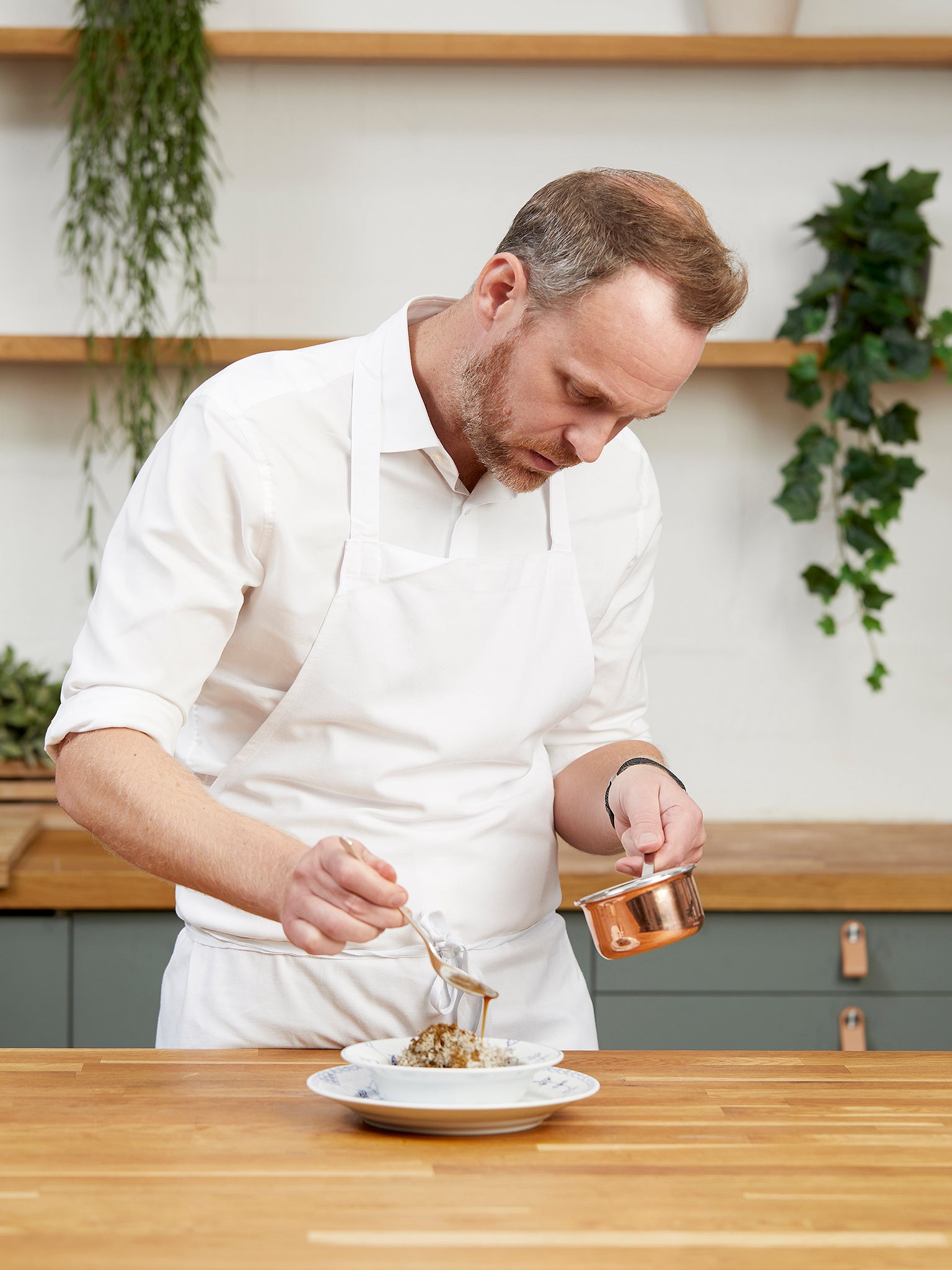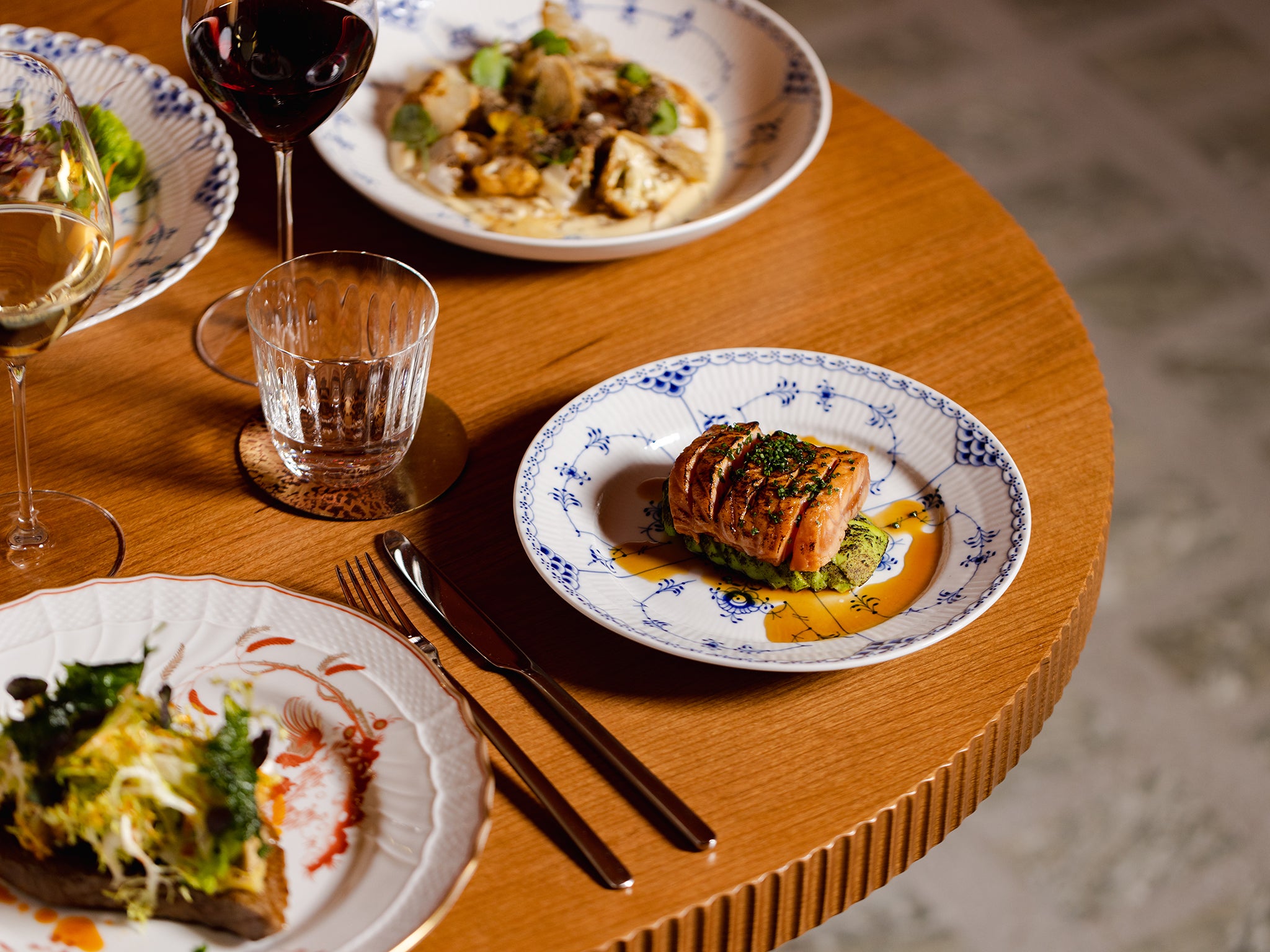
Chef Björn Frantzén has returned to his culinary hometown of London with his latest restaurant, Studio Frantzén. The expansive establishment is located on the fifth floor of Harrods, in what used to be the famous department store’s old hair and beauty salon.
The Swedish chef, whose restaurants in Stockholm and Singapore collectively hold no fewer than six Michelin stars, brings a “hybrid” of the two cuisines he knows best to what he calls “the capital of Europe”.
Studio Frantzén is all about Japandi (Japan-Scandinavian mix) food fusion rather than the popular interiors trend. The restaurant’s interiors are, in fact, quite the opposite from the zen but highly manicured details the Japandi trend is known for. Rather, Frantzén delights in a warm maximalism, with cosy brown and red furniture and eccentric sculptures resting on the walls and counters.
The dish that encapsulates this best is the red deer and tuna tartare starter. Scandinavian red deer, meet Japanese tuna. The blend is further cemented by the use of white kombu and wasabi – distinctly Japanese – with vendax roe from Kalix mingled throughout. Salmon tataki and chicken marinated in shio koji is offered side-by-side with smoked bone marrow and preserved spruce, and lingonberry marshmallow sorbet.
We sat down with Chef Björn to chat about his new venture, why European tasting menus are all wrong, and how the restaurant industry needs to get its “f***ing act together” to keep staff happy.
You lived in London in the early days of your culinary career, before moving back in 2008 to open your first restaurant, Frantzén, in Stockholm. How does it feel to be back?
I feel excited, honoured, proud and concentrated. I need to get it right. For me, London is the capital of Europe and it is my second home. I worked for 10 years before I opened my first restaurant and seven of those years were in London, so almost all my training is from here.
What are some of your favourite memories from your time here?
It’s always Saturday somewhere in London, something’s always happening. I like that, I like big cities.
How did you come to open Studio Frantzén in Harrods?
They called me. It’s an exciting project and time at Harrods because they are focusing so much on food and beverage, and elevating it. I think it’s the place to be right now. I like that it’s a bit of a bizarre thing for the restaurant to be here, it’s like a Willy Wonka land to step in from the store and come in here.

When Harrods called you, were you already thinking about opening a restaurant in London?
We have had several opportunities to open in London, but I hadn’t found the right thing. The success of restaurants is a lot about the partnership and who you’re doing it with. Harrods is a huge organisation and there’s a lot of power in that; they can really get stuff done. It’s been a great collaboration so far.
How long in the making has it been?
Three years. Obviously things are slightly behind, and still, things are delayed with supplies. Things just take longer. Everyone is so behind everywhere, but they’ve been able to keep building most of the time during lockdown, so we’re not that delayed. So it’s OK.
Have you found it difficult because of all the shortages and staffing problems?
I have a lot of friends who are chefs in restaurants here, and they warned me, saying London is a pain in the arse right now, it’s tough. So I was worried, but we are fully staffed. It’s stressful enough to open a restaurant, so it’s nice not to worry about the staff. Thank f*** for that, because it’s very busy! Bookings, oh my god, we had to stop the bookings because all of December was [blows raspberry].
Are you worried or excited?
I would’ve been worried if there was very, very low interest and bookings. I think it’s a luxury problem to be panicking and telling the reservations department to calm the f*** down a little bit. So we’re good.
Studio Frantzén’s food has been described as a “hybrid” of your two other restaurants, which focus on Nordic and Asian, mostly Japanese, cuisine separately. What made you decide to combine them?
It originally came from what we do in our tasting menu at Frantzén, that if you’re going to be able to eat 10, 12, 15 courses, then you need to look into how the Japanese do with Kaiseki. It’s very light, it’s no gluten, no lactose, very low on fat.
That’s part of our philosophy, but then I’m very classically French trained, so I need to put my butter sauce in somewhere. Other than that, we try to keep it nice and light, so you don’t feel so stuffed at the end and you’re rolling out of the restaurant.

Sometimes you go for a tasting menu, and you’re like, oh no, one more dish, and then here comes the main course, f***ing hell, how am I going to do this. Obviously you should not leave a restaurant hungry, but you should feel good.
Nordic and Japanese cuisine, flavour-wise, with fermentation and pickling, are very good to combine.
When did you first fall in love with Japanese cuisine?
About nine or 10 years ago. I had 10 days in Japan and I was travelling from north to south eating my way through the country.
At first, it was a surprise. Their breakfast is rice – I was like, what the f***? I want a sandwich. You can’t eat this much first thing in the morning, that’s how I felt. But after a while I realised, lunch is light, dinner is light, you don’t have all this lactose and gluten all the time, you can actually eat it.
So when I came back to Frantzén, I was like, we’re stuffing the guests. Something’s got to change. We completely messed this up, tasting menu style – the French did, originally, because there were no tasting menus in Europe until they came across Kaiseki. So the French brought it back but they did it with their food, with foie gras, more gluten, bread… I went back and started studying about Kaiseki instead, so our menu is adapted the same way.
What interests you about the future of food?
It’s going to be interesting to see where plant-based cooking goes. There are fewer and fewer fish left in the ocean. My kids are going to only see monkfish in a brochure in the future, what’s going on?
In my restaurants, we don’t work with stuff that’s red-listed and we’re always talking about sustainability. Unfortunately, it just means we have fewer and fewer options to work with, especially on the fish front. It’s not gone the right way in the past 10-20 years.
I think it’s our responsibility to lead the way and push sustainability by using things that are in season and low-waste. But it’s a lot of work nowadays to write a menu.
The other thing is that, unfortunately, the prices of ingredients are crazy and getting worse. If you want wild fish, not farmed, you’ve got to be ready to pay £90 plus tip for a turbot. And that’s where we’re going. It’s a lot of money, but what can we do?
Going back to your former career as a footballer, are there any similarities between being on the pitch and being in the kitchen?
The closest I have ever been to that adrenaline feeling you get 10 minutes before kick-off in the dressing room – where you’re an elite team and you’re a group of people who need to perform together to high expectations – is 10 minutes before you open a restaurant.
A lot of my guys in my Michelin-star restaurant are from elite sport. There’s a former badminton player, one is an ex-ice hockey goalie. I use sports references a lot when I speak to the team. If Frantzén wants to be Real Madrid, we gotta eat right, we gotta sleep right, everything comes together. It’s important.
Is that something you prioritise with your team?
Yeah, we don’t do long hours. It’s quite different, but we need it to be. Because of that, people have been with me for eight, 10, 12 years.
The rest of the restaurant industry needs to get their f***ing act together and start being a little bit more professional. That’s how it is. I did seven years in London, at the beginning of 2000 – oh yeah, I’ve seen a lot! I think it’s about setting clear goals and let everyone know what you expect and how to do it, and be part of it. Things are changing, there’s a new generation. When I came up, I thought it was cool to work 308 hours a month. The new generation doesn’t think it’s cool, you know? So you’ve got to change.




!["[T]he First and Fifth Amendments Require ICE to Provide Information About the Whereabouts of a Detained Person"](https://images.inkl.com/s3/publisher/cover/212/reason-cover.png?w=600)


